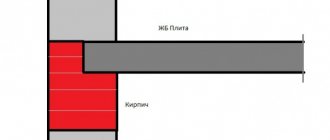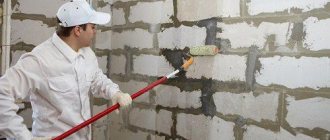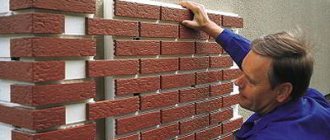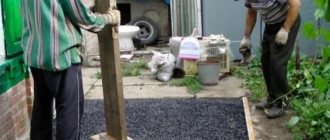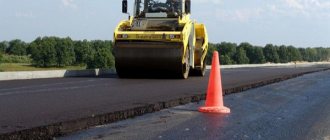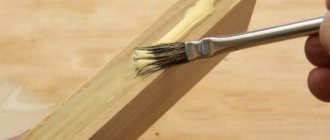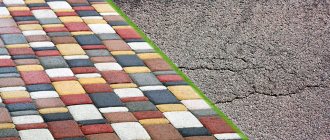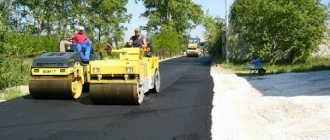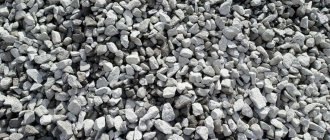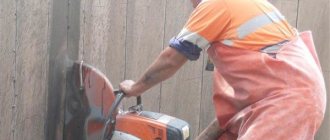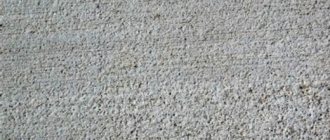What is cold asphalt?
Cold asphalt is called an innovative material for road repair, the use of which opens up new opportunities for public utilities and owners of private territories. This species came to us from abroad quite recently, but has already proven itself well on the Russian market. The unique qualities of the coating allow it to be used in the most extreme conditions, when laying hot asphalt is completely impossible. Many people are interested in the question, what does cold asphalt consist of? What it is?
The product is produced in the form of a ready-made asphalt concrete mixture with the addition of bitumen, polymers and plasticizers. During the production process, all the main components of the material are thoroughly mixed, fine-grained crushed stone and elastic additives are added. The resulting mixture undergoes heat treatment and is sent for packaging.
Cold asphalt is sold in 50 kg bags, 15 kg plastic buckets or in large packages up to a ton.
Dirt standards: what is used on roads?
Let us remember that at the end of December the question was increasingly heard at city forums: “What do they sprinkle on the roads so that the snow on them turns into slippery sticky mud, which then cannot be washed off either the shoes or the car?”
27.12.2017
Silt and clay instead of sand: analysis of dirt on the roads of Novosibirsk
And in order to understand that something was wrong with the sand-salt mixture, the townspeople didn’t even need an examination. “Once I was driving to get some “sprinkler”, and there, mixed with the “mixture”, some pretty big stones flew out of the nozzle and hit passing cars,” “The color of the sand is not the same as sand, and what amazed me: I took it in my hands , rubbed it a little, and it turned to dust. The size does not correspond to the norm, it is smaller. So for the spring and summer we are 200% provided with dust”, “It is known from a person who works at a Daewoo that they sprinkle the most disgusting sand with a very high silt content” - such comments are left by Internet users.
City Council deputy Dmitry Pribalovets and social activist Mikhail Mezentsev got involved in the problem: they took samples of dirt from the road and sent them for examination. Although the results were shocking, the townspeople were not surprised: the sand class did not meet the standards due to the excessive content of dust particles and the amount of clay exceeding GOST by 20 times. It is this clay, motorists are sure, that turns snow into impassable mud in winter, and in summer, with any breeze, it turns into a “sandstorm.”
11.01.2018
Drivers are unhappy with snow removal from Novosibirsk roads
The city authorities responded to the indignation of residents: it was proposed to conduct another examination. As a result, on December 28, in the presence of journalists, representatives of the mayor’s office, as well as Dmitry Pribalovets and Mikhail Mezentsev, went to DEU-1 to take samples of the sand-salt mixture prepared for road maintenance. Samples were taken both from above and in the depression along the entire perimeter of the dumps. Then all the material was mixed and divided into three equal parts, and then packaged and sealed. The mayor's office sent one sample to a testing facility, the community members took the second to the SGUPS laboratory, and the third remained at the sand storage facility - it will be used for additional examination if the results of the other two differ.
And now a test study commissioned by the mayor's office has yielded results: according to the conclusion of experts, the sand fineness modulus is 2.6 mm, the mass fraction of dust and clay particles is 2.5%. “At the same time, according to industry road standards for de-icing materials, in the grain composition of the sand-salt mixture, the mass fraction of particles ranging in size from 1 to 5 mm should be at least 75%, and the mass fraction of dust and clay particles should be no more than 3%,” - they say at the mayor's office. The samples taken fully comply with all the requirements for a sand-salt mixture for roads. But the examination does not answer the question of where the clay on the city’s highways comes from. Perhaps a study of social activists will provide an answer? Its results will be known next week. In the meantime, it is unknown how much longer motorists will have to drown in the clay porridge, and pedestrians will have to scrub their shoes off the sticky mud.
How do they deal with winter off-road conditions abroad?
Not only our country suffers from snow-covered streets in winter. Other northern regions also know how busy the winter season can be for road workers. And they come up with their own ways to deal with ice.
USA and Canada
Here, for sprinkling roads, they use not sodium chloride (the salt familiar to everyone), but magnesium chloride. It is safer for the environment, cars and shoes, and its efficiency is much higher with less consumption. Roads are cleaned with a special vehicle with a trailer and a bucket in front: when it accelerates, the trailer stands across the road and thus cleans a large area.
Finland
Salt is not used to sprinkle roads here; only sand and other abrasive materials are sprayed onto the streets. The main condition for using this technology is that roads need to be cleaned almost to the asphalt immediately after or during a snowfall. And to clear snow faster, they use snowplows with two side plows - as a result, a two-lane road can be easily cleared by one car.
Sweden
For 13 years now, they have been using a method invented by scientist Torgeir Vaa: fine sand in a ratio of 7 to 3 is mixed with hot water at 90–95 °C and sprinkled on the streets. Due to the water, the sand heats up and melts into the snow on the road, making the surface of the highway rough. One such treatment is enough for about a week, subject to daily traffic of about 1,500 cars.
Published in the newspaper “Evening Novosibirsk” No. 3 dated January 19, 2018
Advantages of cold asphalt
The cold method of paving has gained immense popularity due to its simplicity. With the advent of cold asphalt, any homeowner can carry out repairs or make a small asphalt area without special skills or the use of expensive equipment.
Cold asphalt pavement is highly durable, durable and can be used immediately after completion of repair work. As vehicles drive along the repaired area, the asphalt becomes compacted and acquires the necessary hardness.
Composite additives included in the material improve the adhesion of the mixture to the surface, which facilitates the masonry process and guarantees high quality of work performed.
The advantage of this method over hot styling is that the work can be carried out at temperatures down to minus 20 degrees. In this case, preliminary preparation of the surface to be repaired is completely unnecessary. All you need to do with the hole is sweep the dust out of it.
Transportation of the material can be carried out in any weather conditions, in a vehicle of appropriate carrying capacity. Well-packed cold asphalt in bags can be stored almost forever. The opened mixture can be used for a year, which is very convenient.
QUESTIONS and ANSWERS - Cold asphalt ROCKPHALT (Rockfalt)
FAQ (frequently asked questions):
Q: Are additional operations necessary with cold asphalt before laying?
A: The mixture is ready to use. The product is as simplified as possible for the consumer and belongs to the category of “ready-made building mixtures”. The contents of the bag must be kneaded, poured into the prepared place, filled evenly into the space and compacted thoroughly. In winter and autumn, at lower temperatures, cold asphalt becomes coarser and harder, so the bags must be placed overnight in a warm room (above > 16 °C) so that it becomes mobile.
Q: What is the scope of application?
A: Pothole repair of roads, repair of cut out rectangular sections (road maps), repair of trenches, repair around manholes and water intake grates, repair of road surface joints, repair of roadways in parking lots, local areas, gas stations, etc.
Q: What is the material consumption per 1m2
A: For 1 m2 with a layer of 5 cm, the consumption is 95 kg +/- 5%. Consumption depends on the surface of the base (smooth or winding).
Q: What is the recommended layer, minimum layer and maximum layer of material?
A: Recommended layer: 5cm. This thickness will allow you to better cope with loads.
Minimum layer: from 3cm. Provided the base is cleaned and solid.
Maximum layer of material: up to 10 cm. In this case, it is recommended to lay asphalt in layers or add crushed stone to the base to save material.
Q: Is additional work required on the area to be repaired before installation?
A: It is necessary to dedust the area as much as possible and trim the edges. If necessary, the edges and base can be treated with bitumen emulsion or bitumen primer.
Q: Why is bitumen emulsion treatment necessary?
A: There are microcracks along the edge of the pit that are not visible to the naked eye. And it often happens when the patch remains in place after repair, but the edges of the main coating around it begin to collapse. Therefore, to increase the service life of the site, it is advisable to trim the edges and treat them with bitumen cationic emulsion EKSh (cationic bitumen emulsion) or EKShM (cationic bitumen emulsion modified). As an alternative to emulsion, a bitumen primer is used, which has a longer shelf life of up to 6 months. Bitumen emulsion can be used at positive temperatures.
Q: When can the repaired area be opened to traffic?
A: The movement opens instantly. And active vehicle traffic will quickly lead to hardening of the area. Please note that the “pneumatic wheel load” contributes to the recruitment, and not the load of loaders and special equipment with solid rubber wheels and weighing 3-5 tons.
Q: How can I compact it?
A: A hand tamper, vibrating plate, or something that can be used to create a dense, even surface. For areas larger than 1 m², it is advisable to use a vibrating plate. An important condition is the initial compaction, since during it the first adhesion of the stone material to each other and to the surface occurs.
Q: How long does it take to harden?
A: This characteristic is better viewed from a different perspective. Traffic along the repaired area opens instantly, but takes on a solid form gradually, depending on the intensity of traffic and weather conditions. Therefore, the range remains quite wide, but the area can be used regardless of the hardness gain. With heavy traffic, the area can harden in two weeks, and with low traffic it can take up to a month. In the absence of movement or critically high temperatures (more than 30 °C), the period may be extended. Cold asphalt is a special modified composition that remains in a homogeneous state until vehicular traffic begins on the site (pneumatic load on the wheels). Cold asphalt (bitumen) gains strength properties when compressed, so the movement of cars along the repaired area helps to strengthen them.
Q: Is there a need for extra material above the surface of the base coating?
Oh yeah. After uniform distribution, cold asphalt shrinks, which is a consequence of the viscosity of bitumen. Therefore, for every 5 cm of thickness, it is recommended to leave an excess of 1 cm above the surface for subsequent compaction, so that in the future the area will be flush with the main coating. After manual compaction without the use of a vibratory roller or vibratory rammer, slight shrinkage may also occur (on average about 5mm). But all this makes it possible for cold asphalt to fill the space as much as possible, which is not always possible when repairing with hot asphalt (since sometimes the asphalt reaches the repair point when it has cooled down or is poorly rolled out with a roller).
Q: I laid cold asphalt in the summer. And in the sun the first time it is slightly pressed if you press on one point. This is fine?
A: These are the characteristics of the behavior of cold asphalt in hot temperatures. And at low temperatures it becomes harder. Any cold asphalt behaves this way to varying degrees. And even hot asphalt heated in the sun (especially freshly laid), when pressed with a hard object, the bitumen can be pressed or pulled apart. This behavior of cold asphalt is not a disadvantage, but is a consequence of the long-term storage properties of the material, otherwise it would not have been possible to package it. Moreover, this phenomenon is temporary, which usually occurs the first time after installation. But the presence of soft bitumen makes it better to withstand “freeze-defrost” cycles in winter. And bitumen modifiers increase bitumen adhesion and allow the repaired area to stay in place, which is the main purpose of the product. Unfortunately, cold asphalt does not have adhesive properties and it is not worth checking every day whether it has hardened. It will perform its ultimate task of fixing the pothole. With time and traffic, the asphalt will gain strength. It is also possible that there is little traffic in your repair area, which slows down the hardening time (since hardening is 90% dependent on the intensity of compression of the bitumen). After laying in the summer, we recommend sprinkling the asphalt with sand (or cement) to reduce contact with the sun's rays.
Q: Is it possible to use cold asphalt after rain?
A: One of the main advantages of ROCKPHALT cold asphalt is the ability to install on wet surfaces, which hot asphalt does not have. Bitumen modifiers do not allow moisture to affect the bitumen and push it out, bonding the stone materials to each other. But for better adhesion to the surface, it is necessary to carefully sweep the dirt and water out of the hole, and then compact the asphalt concrete.
Q: It is necessary to repair the trench after laying communications. Are there any special features with this type of repair?
A: Trenches are always difficult areas to restore the road surface (for any asphalt), as there is a large shrinkage effect. When laying trenches and other areas where the crushed stone cushion is missing or has been destroyed, it is necessary to perform compaction at all stages of laying. First, pour sand and water to compact it (soil is more difficult to shrink). Then make a crushed stone cushion of 15-20 cm crushed stone. And at the end, a layer of asphalt with a margin of 1-2 cm. If the area sank due to poor compaction, then after a few days you can make another layer of asphalt.
Q: What is the best way to compact cold asphalt?
A: When laying asphalt, it is recommended to use a vibratory plate or vibratory roller to ensure uniform shrinkage of the material. But this does not exclude the possibility of using manual tamping. It’s just that in this case it is necessary to carry out shrinkage more carefully and tightly.
Q: I used the required volume and have half a bag left. Can it be stored further?
Oh yeah. The remaining volume can be used another time before the expiration date. Unlike hot asphalt, it will not harden. Close in the package and place in a warehouse (garage) until next use. It is necessary to avoid direct exposure to sunlight and dust.
Q: This is the first time we encounter cold asphalt. We pressed the bag and expected it to be softer.
A: The building material is new to the consumer and expectations sometimes differ from actual properties. This is normal behavior of cold asphalt. The “hardness effect” creates caking of the material. Moreover, the composition can change mobility when the ambient temperature changes: in winter it is harder, in summer in the sun it is softer. Modified bitumen gives asphalt these properties. After heating and kneading, the material becomes mobile again.
Q: How durable is cold asphalt repair?
A: The product provides a long-lasting result and, if installed correctly, the repaired area can last for several years. But do not forget about different operating conditions, aggressive environments and shock loads. Cold asphalt is a product that is designed to repair potholes and prevent further damage. It makes it possible to fix the problem yourself, but like any other pothole repair, the service life cannot be compared with monolithic laying of the roadway. It is worth separating the service life after laying a new road, repairing a road surface with a short service life or an old road surface that crumbles from time and wear. Before repairs, we advise you to properly assess the area and refrain from repairs if shock loads are present.
Q: What are the important criteria to follow when installing?
A: — When repairing a road surface, asphalt must be laid on an area with a solid base and the presence of walls on all sides.
- You cannot conclude on earth or sand. - We advise you to take general care and thoroughly clean the road around the area being repaired. Dirt and stones scattered along the road can damage the repaired area.— If the hole is located in a place where the road deepens and there is a constant accumulation of puddles, then water hammer may occur in this place, which can reduce the service life of the area.— Along the edge of almost every hole (in the old asphalt) there are microcracks invisible to the eye, so we advise you to trim the edges, and for a better repair, treat the hole with bitumen emulsion (primer). — The product is not intended for repairing the pedestrian area, since without vehicular traffic the area hardens for quite a long time. Sometimes expectations differ from actual properties. Ultimately, the area will harden, but the period may not live up to expectations and the consumer assumes all risks of improper use.— Cold asphalt can be destroyed by impact loads, like any other asphalt, so we advise you to properly evaluate the area before repair.— If asphalt concrete consists of a pothole with flat walls, it is advisable to cut the edges to an angle of 90 degrees so that the mixture has support when loaded from above. - If the thickness of the area exceeds 5 cm, then it is necessary to lay it in layers. - In the modern world, pothole repair of the road surface is considered advisable, when the amount of damage on the road does not exceed 30%. Do not try to restore completely destroyed road surfaces with cold asphalt. And evaluate the areas correctly, because there are such difficulties where asphalt that is not hot or cold will not last long - a major repair or complete reconstruction is needed.
Cold asphalt ROCKPHALT is the only way to repair the road surface yourself and prevent its further destruction. It is easy to use and allows you to carry out work all year round.
ROCKPHALT is an industry standard of European quality with a Ukrainian price!
rockphalt.com.ua
Flaws
Cold asphalt is not recommended for use as the main surface of roads, since under the influence of heavy trucks it loses strength and blurs.
Another important disadvantage is the high cost of liquid asphalt. The price of the mixture for cold masonry is several times higher than the cost of the hot method. Although, if you consider that it is intended only for minor repairs, it will not be so expensive to eliminate the resulting holes with its help.
For comparison, we can give an example of the cost of both road surfaces: 1 ton of ordinary asphalt costs enterprises 2000-2500 rubles, while the price per ton of cold mix reaches 50,000 rubles. But, if you calculate the labor costs of workers and the rental cost of equipment needed for hot pavement, laying cold asphalt turns out to be even more economical.
Laying technology
First of all, the resulting pit is cleared of dust and various debris. For the highest quality adhesion of the base to the new material, the old coating is treated with a bitumen emulsion, on top of which cold asphalt will be laid. What this is and whether this processing is required should be understood before starting work.
The emulsion contains bitumen dissolved in water mixed with various components. The sticky liquid creates the tightest possible connection between the two materials. You can purchase the composition at any hardware store.
If there are cracks and dents on the path, they are filled with a liquid mixture, after which they are repeated over the entire surface with a brush or brush dipped in bitumen emulsion. Next, they begin laying asphalt. It is poured into a hole or onto the territory of the future path and leveled. If there are lumps in the mixture, they must be broken up with any heavy object.
The pits are sealed in several layers, the thickness of which should not exceed 6 cm. Each layer is carefully leveled with a vibrating plate or a regular hoe.
It is very important that the surface of liquid asphalt is 1-2 centimeters above the level of the old road surface. During the rolling process, the mixture will be compacted and settle to the required depth. This technology is used for road repairs. Cold asphalt allows you to use a new coating immediately after completion of work.
If not sand and salt, then what?
As we were told by the road committee, all de-icing materials are divided into two types - solid (including granular) and liquid. Liquid ones are used for “preventive treatment” before precipitation and are used at air temperatures not lower than minus 6 degrees. If asphalt, already covered with an ice crust, is treated with a liquid mixture, then the likelihood of car wheels slipping will only increase. Such a reagent will take effect only after some time.
But even if our climatic conditions allowed the use of liquid reagents, we would face other problems. This includes additional re-equipment of the vehicle fleet and the construction of special brine preparation stations. In short, liquid reagents are not the Kaluga option at all.
What about solid reagents?
Some cities have experience using a mixture of salt with marble chips or crushed granite - environmentally friendly materials that act on ice solely as an anti-slip agent. With proper organization of application and subsequent cleaning of the area, this mixture can be used repeatedly. It seems like there are a lot of benefits for the environment, but they are still very expensive. The crumbs can be reused, but before doing so they must be washed and disinfected.
All this is quite an expensive pleasure. “Experiments” with granite chips in St. Petersburg were carried out back in the late 90s. However, the experiment was unsuccessful: the crumbs, along with the melted snow, fell into the city sewer system and clogged the pipes, causing many streets to be flooded.
Time to sprinkle...
Roads in the city are also cleaned and sprinkled according to a certain technology and time frame. Within the city, roads are divided into three categories according to their transport and operational characteristics.
Roads of categories 1 and 2 are treated with reagents within 3 hours from the beginning of the snowfall, then swept and re-treated. If the snowfall is prolonged, then the next sweeping of the roadway is carried out after every 5 cm of freshly fallen, uncompacted snow falls, followed by treatment of the roadway with de-icing materials.
On roads of the 3rd category, single-operation, reagent-free snow removal is used no later than 6 hours after the end of the snowfall.
In places of increased danger - descents, ascents, bridge structures, etc. — technological monitoring is carried out in terms of checking the condition of the roadway at least 2 times a day and, if necessary, additional treatment of the roadway is carried out.
Sidewalks, bus stops and other pedestrian areas are cleared of snow, swept and sprinkled immediately after the snowfall ends.
Scope of application
Cold asphalt is most often used for urgent repairs of road surfaces in places where vehicle traffic cannot be stopped. It is advisable to use the material for repairing foundations, hard-to-reach areas of roads, storm drains, manholes, recreation areas and other small surfaces.
Owners of private houses often use cold asphalt to design parking lots, floors on verandas and gazebos, as well as permanent paths. Its price is of course high, but since the purchased mixture can be used for a long time, it is an ideal option for periodic private repairs.
